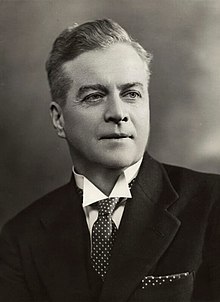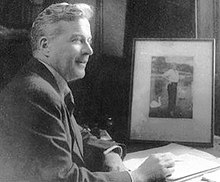Lionel Logue
Lionel Logue | |
|---|---|
 Logue in 1937 | |
| Born | 26 February 1880 College Town,Adelaide,South Australia |
| Died | 12 April 1953(aged 73) London, England |
| Known for | Speech therapist toKing George VI |
| Spouse |
Myrtle Gruenert
(m.1907; died 1945) |
| Children | 3, incl.Valentine Logue |
| Scientific career | |
| Fields | Speech andelocution |
| Institutions | British Society of Speech Therapists Royal College of Speech Therapists |
Lionel George Logue,CVO(26 February 1880 – 12 April 1953) was an Australianspeech and language therapistand amateurstage actorwho helpedKing George VImanage hisstammer.
Early life and family[edit]
Logue was born on 26 February 1880 inCollege Town, South Australia.He was the oldest of four children born to Lavinia (née Rankin) and George Edward Logue.[1]His father was an accountant at his grandfather's brewery who later managed the Burnside Hotel and the Elephant and Castle Hotel.[2]His grandfather Edward Logue, originally fromDublin,was the founder ofLogue's Brewery,a predecessor of theSouth Australian Brewing Company.[3]His uncle by marriage was barrister and social activistParis Nesbit.[4]
Logue attendedPrince Alfred Collegebetween 1889 and 1896. Unable to decide what to study, Logue came acrossLongfellow'sThe Song of Hiawatha:[5]
Then Iagoo, the great boaster,
He the marvellous story-teller,
He the traveller and the talker,
He the friend of old Nokomis,
Made a bow forHiawatha
The poem's rhythm inspired Logue to put his interest in voices to good use.[2]After leaving school at sixteen, he receivedelocutiontraining from Edward Reeves. Reeves had moved to Adelaide in 1878 and taught elocution to his pupils by day and gave popular recitals to audiences in Victoria Hall by night. Logue worked for Reeves as a secretary and assistant teacher from 1902, while studying music at theUniversity of Adelaide'sElder Conservatorium.While working for Reeves, Logue began to give recitals of his own for which he was praised for his "clear, powerful voice."[6]
After his father died on 17 November 1902, Logue set up his own practice as a teacher of elocution. By 1904, he had gained a good reputation and was receiving praise from the local newspapers.[7]However, he decided to take a contract with an engineering firm some 2,000 kilometres (1,200 mi) westward inKalgoorlie,Western Australia,installing an electricity supply at a gold mine.[7][1]
Professional career[edit]

His professional career began inPerth,where, in addition to teaching elocution, acting, and public speaking, he put on plays and recitations, and also founded a club for public speakers. He was also involved withYMCAPerth and schools such asMethodist Ladies' College,Loreto Convent,Scotch College,Perth Technical School,andClaremont Teachers College.
In 1911, Logue and his wife set out on a tour of the world to study methods of public speaking. Later he developed treatments for AustralianFirst World Warwar veterans who hadshell shock-inducedimpaired speech.[8]In addition to physical exercises, which helped with patients' breathing, Logue's distinctive therapy emphasised humour, patience, and "superhuman sympathy".
In 1924, Logue took his wife and three sons to England, ostensibly for a holiday. Once there, he took jobs teaching elocution at schools around London, and in 1926 he opened a speech-defect practice at 146Harley Street.Logue used fees paid by wealthy clients to subsidise patients unable to pay. It was here that the Duke of York – the futureKing George VI– sought Logue's help.[9]Logue became a founding fellow of theRoyal College of Speech and Language Therapistsin 1944.[10]
Treatment of George VI[edit]
As a speech therapist, Logue was self-taught and was initially dismissed by the medical establishment as aquack,but he worked with the Duke from the late 1920s into the mid-1940s.[11]
Before ascending the throne as George VI, the Duke of York dreaded public speaking because of a severestammer;[12]his closing speech at theBritish Empire ExhibitionatWembleyon 31 October 1925 proved an ordeal for speaker and listeners alike. The Duke resolved to find some way to manage his stammer, and engaged Logue in 1926[13][14]after being introduced to him byLord Stamfordham.[15]
Diagnosing poor co-ordination between the Duke'slarynxandthoracic diaphragm,Logue prescribed a daily hour of vocal exercises. Logue's treatment gave the Duke the confidence to relax[16]and avoid tension-induced muscle spasms. As a result, he only occasionally stammered. By 1927, he was speaking confidently and managed his address at the opening of theOld Parliament HouseinCanberra[17]without stammering.[18]
Logue was often called over the years when the king was expected to make a speech, and was regularly invited to the royal family's Christmas dinner party in order to assist with theChristmas message.[19]Their relationship was featured ina film,a playanda book.[11]
Honours[edit]
In 1944, King George VI appointed Logue aCommander of the Royal Victorian Order(CVO), elevating him from Member of the Order (MVO), which had been conferred upon Logue at the time of George VI's Coronation.[14][20][21][22]
King George VI died on 6 February 1952. On 26 February 1952, Logue wrote to the late king's wife,Queen Elizabeth The Queen Mother:
No man ever worked as hard as he did, and achieved such a grand result. During all those years you were a tower of strength to him and he has often told me how much he has owed to you, and the excellent result could never have been achieved if it had not been for your help. I have never forgotten your gracious help to me after my own beloved girl passed on.[23]
The Queen Mother replied: "I think that I know perhaps better than anyone just how much you helped the King, not only with his speech, but through that his whole life and outlook on life. I shall always be deeply grateful to you for all you did for him."[24][25]
Personal life[edit]

Logue married Myrtle Gruenert, a 21-year-old clerk, atSt George's Anglican Cathedral,Perth,on 20 March 1907.[26]They had three sons,Valentine,Laurie, and Anthony.[27]Valentine trained atKing's College LondonandSt George's Hospitaland went on to become one of the most distinguished neurosurgeons of his generation.[28]
Lionel Logue was aFreemason,initiated, passed, and raised in 1908, and becameWorshipful Masterin 1919; he was a member of St. George's Lodge (now J.D. Stevenson St. George's Lodge No.6, Western Australian Constitution).[29][30]
He lived in a 25-room Victorian villa called Beechgrove inSydenhamfrom 1932 until 1947,[31]now demolished and part ofSydenham Hill Wood.
Myrtle died suddenly from a heart attack in June 1945,[32][33]and Logue died in London, on 12 April 1953. His funeral was held on 17 April inHoly Trinity Bromptonbefore his body was cremated.[34]Representatives ofQueen Elizabeth IIandQueen Elizabeth The Queen Motherattended the funeral.[35]
In popular culture[edit]
WithPeter Conradi,Logue's grandson Mark wrote a book,The King's Speech: How One Man Saved the British Monarchy,about his grandfather's relationship with the king.[36]In the 2010 British filmThe King's Speech,written byDavid Seidler,Logue was played byGeoffrey Rush,his wife byJennifer Ehle,and his patient byColin Firth.In the West End stage adaptation ofThe King's SpeechatWyndham's Theatre,Australian actorJonathan Hydeplayed Lionel Logue, and in the US stage premiere, Logue was played byJames Frain.
Welsh actorMichael Elwynplayed Logue in the 2002 television filmBertie and Elizabeth.Derek Lawson portrayed Logue in the 2015 comedyA Royal Night Out.
See also[edit]
References[edit]
Notes[edit]
- ^abEdgar, Suzanne."Logue, Lionel George (1880–1953)".Australian Dictionary of Biography.Australian National University.Retrieved17 December2010.
- ^abLogue and Conradi, p. 16.
- ^Logue, Mark; Peter Conradi (2010).The King's Speech: How One Man Saved the British Monarchy.Quercus, London. p.15.ISBN978-0-85738-110-1.
- ^"Engagements".Critic.Adelaide. 28 March 1906.
- ^Longfellow, Henry Wadsworth (1876).The poetical works of Henry Wadsworth Longfellow.Boston: Osgood & Co. p. 148.
- ^Logue and Conradi, p. 18.
- ^abLogue and Conradi, p. 19.
- ^"Stuttering and The King's Speech".The Stuttering Foundation.Retrieved17 December2010.
- ^Logue and Conradi, p. 39.
- ^Bowen, Caroline (2011)."Lionel Logue: A Pioneer in Speech-Language Pathology".The ASHA Leader.16(2): 10–12.doi:10.1044/leader.FTR1.16022011.10.Retrieved1 May2011.
- ^abThe Daily TelegraphThe King's Speech: how Lionel Logue cured King George VI's stammer
- ^Drabble, Margaret."Public Speech and Public Silence".The British Stammering Association. Archived fromthe originalon 28 September 2007.Retrieved17 December2010.
- ^Bousfield, Arthur; Toffoli, Garry (2002).Queen Elizabeth the Queen Mother, 1900–2002: The Queen Mother and Her Century.Dundurn Group (CA). p. 50.ISBN978-1-55002-391-6.
- ^ab"Mr. Lionel Logue".The Times.No. 52, 594. London. 13 April 1953. p. 8.Retrieved29 April2011.
- ^BBC,Note reveals story behind King's speech film,1 March 2011.
- ^Erickson, Carolly (2005).Lilibet: An Intimate Portrait of Elizabeth II.St. Martin's Press. p. 15.ISBN978-0-312-33938-8.
- ^"Official Opening of Canberra by His Royal Highness the Duke of York".AustralianNational Film and Sound Archive.1927.
- ^Shawcross, William(2009).The Queen Mother: The Official Biography.Knopf Doubleday Publishing Group. p. 460.ISBN978-1-4000-4304-0.
- ^"One Man Saved King's Voice: Beat time as he spoke to world".Sunday Pictorial.No. 1, 925. 10 February 1952. p. 3.
- ^"No. 34396".The London Gazette(Supplement). 11 May 1937. p. 3084.
- ^"No. 36544".The London Gazette(Supplement). 2 June 1944. p. 2571.
- ^David Seidler(screenwriter) (2010).The King's Speech(Motion picture). UK: See-Saw Films. Event occurs at 1:51:43.
- ^Logue to Queen Elizabeth, the Queen Mother, 26 February 1952, The National Archives (U.K.)
- ^The Queen Mother to Lionel Logue, 28 February 1952, The National Archives (U.K.)
- ^Walker, Tim (6 December 2010)."Queen Elizabeth's posthumous endorsement of Lionel Logue".The Daily Telegraph.London.Retrieved2 June2013.
- ^Logue and Conradi, p. 20.
- ^Logue and Conradi, p. 35.
- ^"Logue, Valentine Darte (1913 - 2000)".livesonline.rcseng.ac.uk.
- ^"Film" The King's Speech "".Mastermason.com Forums.18 February 2011. Archived fromthe originalon 16 August 2011.Retrieved26 March2011.
- ^"The King's Freemasonry".Freemasonry Today magazine.March 2011.Retrieved21 February2014.
- ^Logue and Conrad pp 94 and 212.
- ^"Lionel Logue and His Wife Myrtle".Awesome Stories.Retrieved2 June2020.
- ^"Forgotten archive reveals true story behind 'King's Speech'".
- ^"Deaths".The Times.London. 14 April 1953. p. 1.
- ^"Court Circular".The Times.London. 18 April 1953. p. 8.
- ^Logue, Mark; Peter Conradi (2010).The King's Speech: How One Man Saved the British Monarchy.Quercus, London.ISBN978-0-85738-110-1.
Sources[edit]
- Australian Dictionary of Biography
- BBCInterview with Mark Logue(4 January 2011), about finding Lionel Logue's notes
- "Chance Meeting Led to Cure of King's Stutter",The Sydney Morning Herald(Monday, 11 February 1952), p. 3.
- Darbyshire, T.,The Duke of York: an intimate and authoritative life story of the second son of Their Majesties the King and Queen by one who has had special facilities, and published with the approval of His Royal Highness,Hutchinson, (London), 1929
- Logue, Mark;Conradi, Peter(November 2010),The King's Speech: How One Man Saved the British Monarchy,London: Quercus,ISBN978-0-85738-110-1(Note: co-author Mark Logue is a grandson of the subject, Lionel Logue).
- Moses, E., & E. M. Foley,"The King's Speech",The Sydney Morning Herald,(Thursday, 24 December 1936), p. 5.
- Rhodes James, Robert(1998),A Spirit Undaunted: The Political Role of George VI,London: Little, Brown and Co,ISBN978-0-316-64765-6
- St. Claire, M."An Australian Cures Defect in King's Speech",The Australian Women's Weekly,(Saturday, 2 January 1937), p. 12
External links[edit]
- "Lionel Logue 'never swore in front of King George VI'",BBC Radio Leicester
- Bowen, Caroline (2002).Lionel Logue: Pioneer speech therapist.Retrieved 1 January 2011
- Hutchinson, Norman C. (2010).Lionel Logue: the King's Mentor,self-published, Box Hill South, Victoria, Australia
- *"King Honors Australian Who Alleviated Stammer",New York Times,(11 May 1937)
- Letter sent by Logue to George VI,Royal College of Speech and Language Therapists archives
- Rare photo of Lionel Logue near the end of his life, from the UK National Archives
- 1880 births
- 1953 deaths
- Australian Christian Scientists
- Australian Commanders of the Royal Victorian Order
- Australian expatriates in the United Kingdom
- Australian people of Irish descent
- Australian scientists
- People educated at Prince Alfred College
- People from Adelaide
- Speech and language pathologists
- Stuttering
